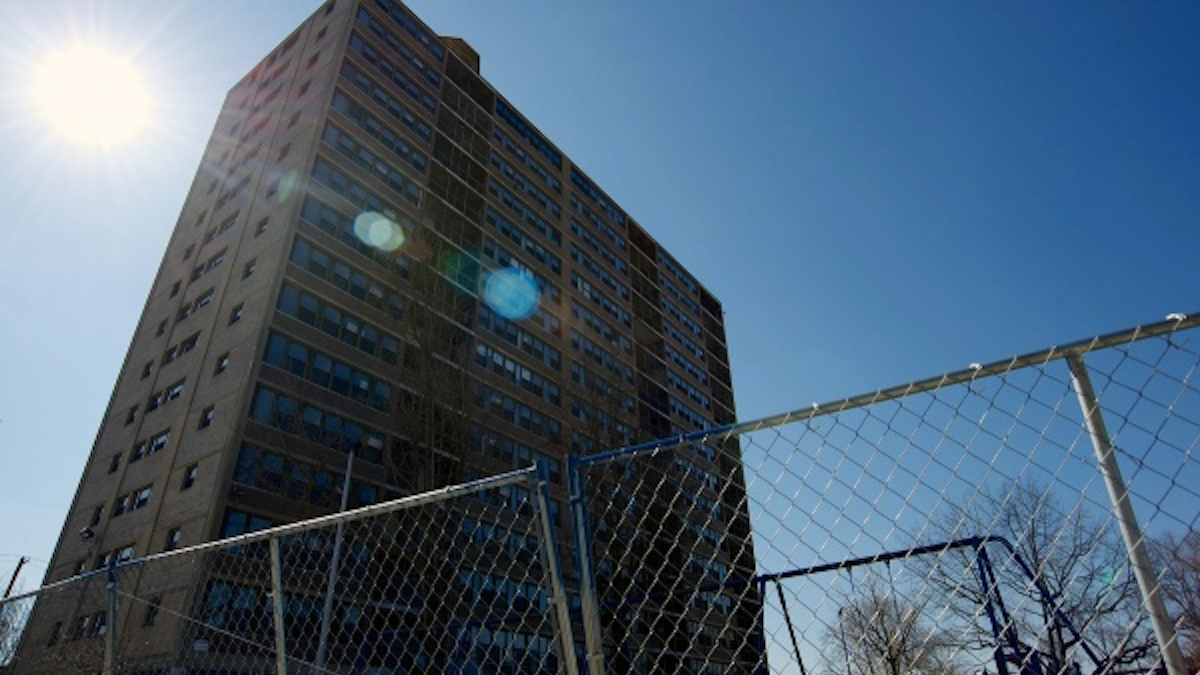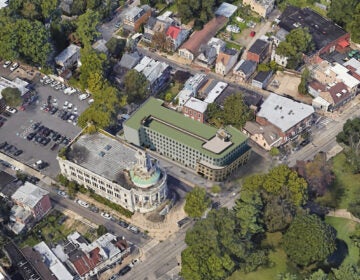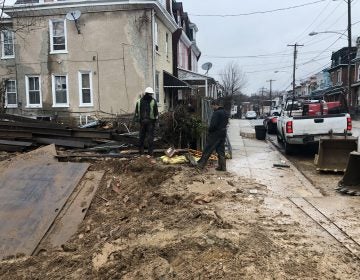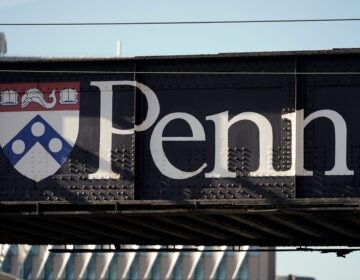PHA director: Queen Lane Apartments may not be torn down after all

The Philadelphia Housing Authority’s plans to redevelop the site of a shuttered high-rise in Germantown have reached a tipping point.
It’s been more than two years since PHA first presented its intent to demolish Queen Lane Apartments on the neighborhood’s west side and replace it with a 55-unit, low-density development.
Minimal agreement dashed
With the start of construction potentially another year away, the agency’s top official is now saying it’s “seriously considering” gutting and revamping the existing 16-story property instead.
“We’ve spent hundreds of thousands of dollars and we’re nowhere closer to where we were,” said Kelvin Jeremiah, PHA’s executive director.
Several residents were upset by the possibility when it was floated during community meetings held last year.
Tearing down the building has been perhaps the only facet of the project on which most of the neighborhood agreed.
$32 million gone
However, Jeremiah said the loss of a key tax credit for the project — a roughly $32 million budget shortfall tied to the federal sequester and PHA’s overarching mission to provide housing for the thousands on its waiting list — has left the organization weighing the benefits of letting a structurally sound building sit empty for much longer.
“A better life for low-income Philadelphians is what we’re most concerned about,” he said.
A still-pending environmental review of the site continues to sit at the center of the delay, the longest for a PHA project involving the demolition of a high-rise.
WHYY is your source for fact-based, in-depth journalism and information. As a nonprofit organization, we rely on financial support from readers like you. Please give today.
PHA director: Queen Lane Apartments may not be torn down after all

Will the sun always shine on the embattled Queen Lane Apartments tower? (Bas Slabbers/for NewsWorks)
The Philadelphia Housing Authority’s plans to redevelop the site of a shuttered high-rise in Germantown have reached a tipping point.
It’s been more than two years since PHA first presented its intent to demolish Queen Lane Apartments on the neighborhood’s west side and replace it with a 55-unit, low-density development.
Minimal agreement dashed
With the start of construction potentially another year away, the agency’s top official is now saying it’s “seriously considering” gutting and revamping the existing 16-story property instead.
“We’ve spent hundreds of thousands of dollars and we’re nowhere closer to where we were,” said Kelvin Jeremiah, PHA’s executive director.
Several residents were upset by the possibility when it was floated during community meetings held last year.
Tearing down the building has been perhaps the only facet of the project on which most of the neighborhood agreed.
$32 million gone
However, Jeremiah said the loss of a key tax credit for the project — a roughly $32 million budget shortfall tied to the federal sequester and PHA’s overarching mission to provide housing for the thousands on its waiting list — has left the organization weighing the benefits of letting a structurally sound building sit empty for much longer.
“A better life for low-income Philadelphians is what we’re most concerned about,” he said.
A still-pending environmental review of the site continues to sit at the center of the delay, the longest for a PHA project involving the demolition of a high-rise.
The long timeline
Not long after plans for Queen Lane were presented to the community, a Potter’s Field was discovered beneath the site.
The colonial burial ground added a complex layer to the so-called Section 106 Agreement, which must be executed when a project with historic significance receives federal funding.
At the request of residents, PHA agreed not to build on the Potter’s Field, forcing the agency to alter its original design for the site and conduct two archeological surveys to definitively determine the boundaries of the burial ground.
To date, no human remains have been discovered and nothing has indicated that the burial ground extends beyond the roughly two-acre footprints found on a pair of historic maps of the site.
That leaves the Section 106 Agreement, brokered by the U.S. Department of Housing and Urban Development, in its final phase.
Once completed, the federal agency can give PHA the green light to prepare for demolition.
“We’re seeing the light at the end of the tunnel right now,” said Monica Hawkins, the division director for HUD that has overseen the process for Queen Lane.
What now?
A programmatic agreement is the one of the remaining steps.
The legal document maps out what actions will be taken going forward in case any historic resources are found either during additional archeological digs, during demolition or construction.
Hawkins said HUD anticipates the Section 106 Agreement to be finalized “no more than 30 to 60 days” after the PA is executed.
Comments from signatory agencies — the Department of Housing and Urban Development, PHA, the Advisory Council on Historic Preservation and Pennsylvania Historical Museum Commission — are scheduled to be submitted by Sept. 23.
Why it may not fall
PHA may still opt to keep the high-rise standing.
“It would cost us less to go in and rehab the building,” said Jeremiah, noting that PHA could do everything in-house.
The project’s price tag is $24 million. The figure includes the cost of demolition and construction.
It would cost roughly $20 million to rehab the existing tower.
Jeremiah said PHA will make a call one way or the other in October, when the agency can apply for new tax credits through the Pennsylvania Housing Finance Agency.
In 2011, PHA was awarded nearly $8 million worth of Low Income Housing Tax Credits, allocated by state agencies to address local housing needs.
With demolition nowhere in sight, however, PHA was not in a position to sell the non-competitive credits to the private investment firm that had agreed to purchase them when a commitment letter between the two parties expired.
“Until there is some certainty around the time for completion of the historic review process, PHA cannot proceed with re-securing these funding sources, as market conditions change daily,” said PHA spokesperson Nichole Tillman in an email.
PHA’s annual budget is more than $300 million.
If it comes down…
If PHA decides to move forward with demolition and redevelopment, any work at the site would likely have to wait until March at the earliest.
Guidelines set by the city’s Office of Emergency Management prohibit implosion demolitions – in which a building is rigged to collapse on itself — between Dec. 16 and March 1.
Possible sub-freezing temperatures during that stretch are a major concern. To cut down on dust during demolition, contractors typically water down the site.
A waiver can be granted by the city Managing Director’s Office, but only if a property is an “imminent danger” to the “health, welfare and safety of citizens,” said Mary Stitt, that office’s chief of staff.
“Implosions are rare,” said Stitt. “Implosions during that period are even rarer.”
Tillman said the project is scheduled to be completed midway through 2015.
Some things are certain
Either way, Jeremiah said there will be public housing at Queen Lane.
In the meantime, members of Northwest Neighbors of Germantown, a community group that formed in response to the Queen Lane project, are continuing to advocate for a more aesthetically pleasing design plan.
“We don’t want it to look like a project. We want it to look like townhomes,” said Lisa Hopkins, who leads the group.
The group is also requesting that PHA arrange another archeological excavation of the site that takes a closer look at the area outside of the known boundaries of the Potter’s Field.
“They only dug three feet outside of Potter’s Field,” said Hopkins.
View from across the street
On a recent weekday afternoon, Melvin Gore and Dwain Bryant sat on a front porch on West Queen Lane, which sits a stone’s throw from the shuttered tower.
They too would like to see PHA build the low-rise development.
They’ve always considered the tower an eye sore and a nuisance. They said replacing the tower would be an improvement to the neighborhood.
“That’s where all the trouble came from,” contends Bryant.
Still, neither expects anything to happen at the site anytime soon. Gore said he was surprised PHA even closed the building in the first place.
“We’re just happy with small miracles,” he said.
Corliss Gray, president of the Queen Lane Tenant Council and a resident of West Penn Street, is more frustrated with all of the delays.
She’d prefer to see PHA build the new development, but doesn’t oppose PHA rehabbing the existing building either.
“If they want to fix that building and put the right people in there I’m fine with it,” said Gray.
For now, though, all Gray and the neighborhood can do is wait a bit longer to see what happens.
WHYY is your source for fact-based, in-depth journalism and information. As a nonprofit organization, we rely on financial support from readers like you. Please give today.









